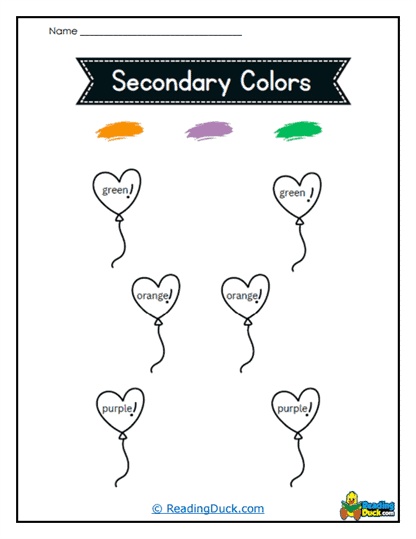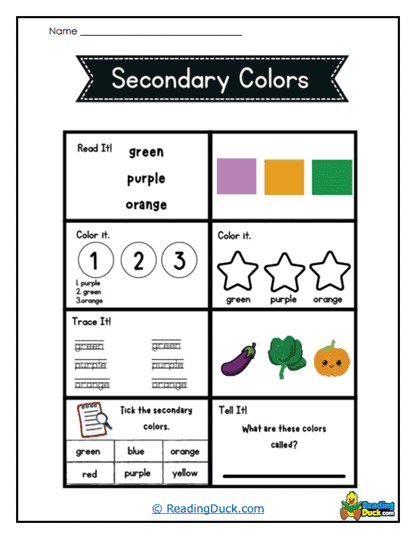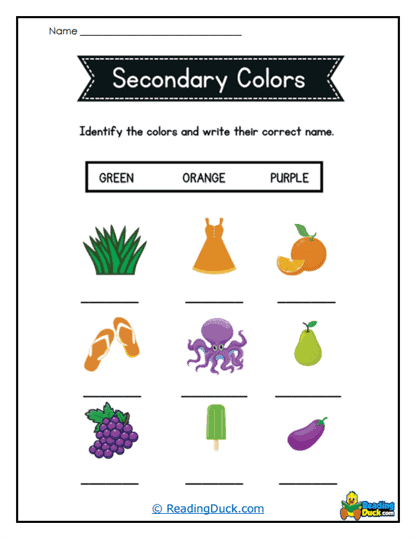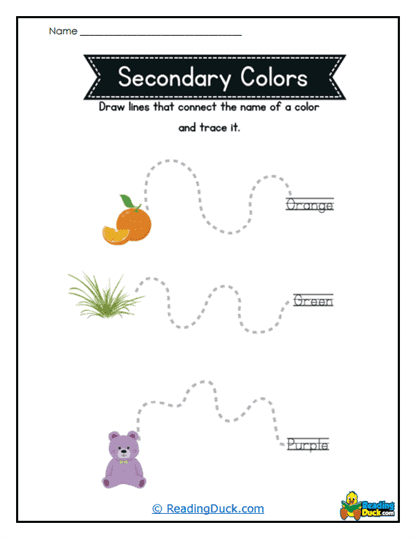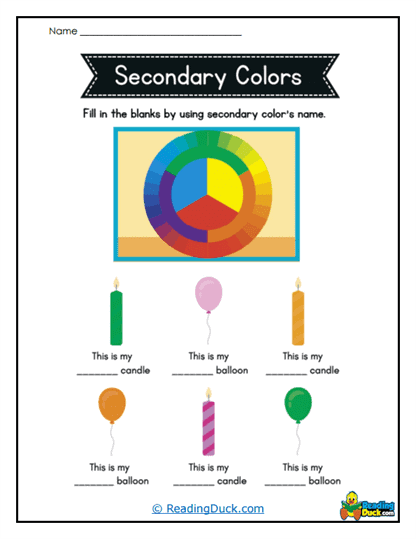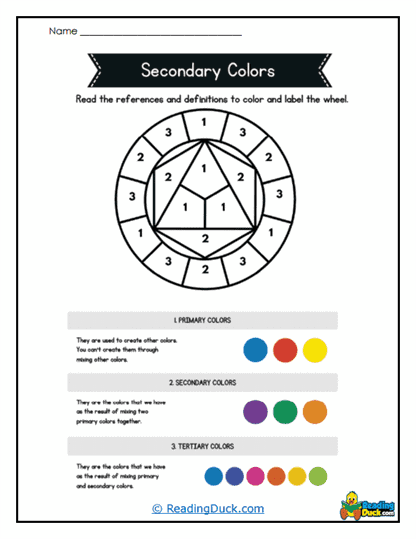Secondary Colors Worksheets
About Our Secondary Colors Worksheets
This collection of worksheets introduces young students to the concept of Secondary colors in a structured, engaging way. These worksheets focus on teaching students about the three main Secondary colors: orange, green, and purple, which are created by mixing primary colors (red, yellow, and blue). Through these worksheets, students gain an understanding of how colors work together to form new shades, helping them recognize and differentiate between different colors. This foundational learning in color theory is essential for young learners as it introduces them to concepts they will build on in future art and science studies.
The purpose of these worksheets extends beyond just identifying colors. They are designed to enhance a child's ability to recognize, mix, and name colors, which are crucial skills in both early art education and everyday observation. These worksheets encourage hands-on engagement, allowing students to learn by doing rather than just observing. This makes learning about colors a more interactive and memorable experience. For many young learners, this interaction with colors also sparks creativity and curiosity, laying the groundwork for a lifelong appreciation of art and color.
These worksheets include a variety of visuals and layouts to attract young students' attention. Bright colors, simple shapes, and fun illustrations are common features that make these worksheets appealing and accessible. The worksheets often present colors in large, easy-to-see areas that students can fill in, trace, or match, which helps maintain their focus and makes it easier for them to understand the relationships between colors. Additionally, these visuals are often accompanied by clear, simple instructions, so students know exactly what they need to do to complete each task.
Both teachers and homeschoolers use these worksheets as fundamental tools in color education. They provide an organized, straightforward way to introduce essential color concepts in a fun and manageable format. For homeschooling parents, these worksheets offer a practical way to guide their children through early art and science concepts at home. In traditional classrooms, teachers use these worksheets to support a structured lesson plan on colors, making them versatile resources for different learning environments.
Student Tasks
In Secondary Colors worksheets, students perform a variety of tasks that help them understand and recognize Secondary colors. One common activity is color matching, where students are asked to match colors with similar shades or identify colors that result from mixing two primary colors. This task encourages children to observe closely and make connections between colors, helping them understand the concept of mixing to create new shades. Another popular task is color identification, where students learn to pick out Secondary colors from a group of colors, which reinforces their ability to recognize and name these colors.
These worksheets often include exercises such as sorting, grouping, or coloring different objects in designated Secondary colors. For example, students might color fruits, animals, or everyday objects like flowers in the correct Secondary colors, helping them see these colors in familiar contexts. This type of task makes color learning more relatable and practical by connecting it to things students encounter in their daily lives. Sorting and grouping activities help students categorize colors, which also strengthens their cognitive skills by teaching them to organize information.
Hands-on activities, like painting or using colored pencils, are also commonly recommended alongside these worksheets. These activities allow students to physically mix colors, giving them a more tangible understanding of how Secondary colors are formed. Teachers or parents might encourage students to mix two primary colors with paint to see how orange, green, or purple appear, adding a sensory aspect to learning. This kind of hands-on interaction is especially beneficial because it involves multiple senses, making the learning experience richer and more memorable.
These varied tasks are designed to reinforce color concepts through repetition and different activity formats. By engaging in multiple types of activities, students gain a more well-rounded understanding of Secondary colors and are more likely to remember what they have learned. Whether they are coloring, sorting, or mixing, each activity reinforces the core concept in a unique way, building a solid foundation for future learning in color theory and art.
Skills Developed
Working with Secondary Colors worksheets helps students develop several essential skills beyond just color recognition. One key skill is visual literacy, which is the ability to interpret and understand visual information. By learning to identify and categorize colors, students practice organizing visual information in a way that will support their understanding of more complex concepts later. These worksheets also lay the groundwork for early problem-solving skills, as students must make decisions about which colors to use and how to organize them.
Fine motor skills are another significant benefit of using these worksheets. Many of the tasks, such as coloring within lines or tracing shapes, require students to control small hand movements carefully. These actions contribute to the development of hand-eye coordination and dexterity, which are essential for various activities both in and outside the classroom. Coloring within lines, in particular, requires concentration and precision, helping students build control over their motor functions in a fun and engaging way.
Secondary Colors worksheets can improve students' concentration and attention to detail. Many of the exercises ask students to differentiate between colors that may look similar, so they need to pay close attention to subtle differences. This focus helps children develop patience and persistence as they work through tasks that require them to look closely and think carefully. As they complete these worksheets, students gradually strengthen their ability to concentrate on details, a skill that will be valuable in many areas of learning.
In working with colors, students also enhance their cognitive skills as they memorize, categorize, and organize information. Identifying different colors and understanding how they relate to each other builds memory skills, as students must remember which colors mix to make others. This mental exercise supports early cognitive development by helping children learn to store and retrieve information, an essential ability for academic success in all subjects.
The Importance the Collection
Secondary Colors worksheets are a vital part of early education because they help lay the foundation for more complex art and science concepts. Understanding color is one of the first steps in learning about visual elements, and these worksheets introduce students to this concept in a way that is accessible and engaging. By mastering Secondary colors, students gain a better understanding of the world around them and are better prepared for future learning in subjects like art, design, and even science, where color often plays a role in understanding different materials and reactions.
These worksheets align with early learning frameworks, which emphasize hands-on, experiential learning. The understanding of colors is not only useful in art; it also supports cross-curricular learning. For example, teachers might use color exercises to introduce math concepts, like sorting and grouping, or to enhance literacy skills by associating colors with words. Through these connections, color worksheets become tools for integrated learning, showing students how different subjects can work together and broadening their educational experience.
The worksheets also set the stage for more complex concepts by introducing students to the basics of color theory. As students progress in their education, they will encounter more advanced art lessons that require a foundational understanding of color. These worksheets give them a head start by familiarizing them with color mixing and color recognition, making it easier for them to understand advanced ideas in later lessons. Additionally, color theory is an essential concept in fields like graphic design and visual arts, so early exposure can spark interest in these areas.
These worksheets enhance student confidence as they gain foundational knowledge in a way that feels fun and approachable. Completing each task gives students a sense of accomplishment, which can boost their self-esteem and motivate them to continue learning. By understanding something as universal and visible as color, students feel more connected to the world around them, which can foster a love of learning and exploration that benefits them well beyond the art classroom.
